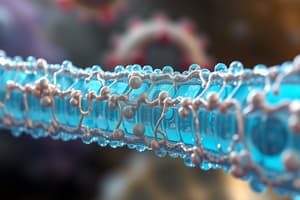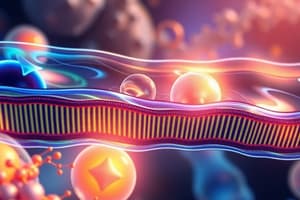Podcast
Questions and Answers
What is the primary structural component of cell membranes?
What is the primary structural component of cell membranes?
- Proteins
- Glycolipids
- Cholesterol
- Phospholipids (correct)
What role does cholesterol play in the cell membrane?
What role does cholesterol play in the cell membrane?
- To assist in cell recognition
- To prevent phospholipids from being too tightly packed (correct)
- To create a rigid structure
- To form a barrier against all molecules
What feature distinguishes glycolipids from other lipids in the cell membrane?
What feature distinguishes glycolipids from other lipids in the cell membrane?
- They contain a carbohydrate sugar chain (correct)
- They are found only in plant cells
- They are involved in energy storage
- They are hydrophobic in nature
Which part of a phospholipid is attracted to water?
Which part of a phospholipid is attracted to water?
What is the function of the semi-permeable nature of the lipid bilayer in cell membranes?
What is the function of the semi-permeable nature of the lipid bilayer in cell membranes?
Why is cholesterol not found in the membranes of plant cells?
Why is cholesterol not found in the membranes of plant cells?
What characteristic of phospholipids contributes to their arrangement in cell membranes?
What characteristic of phospholipids contributes to their arrangement in cell membranes?
Which of the following describes the function of proteins associated with the cell membrane?
Which of the following describes the function of proteins associated with the cell membrane?
What is a primary characteristic of integral membrane proteins?
What is a primary characteristic of integral membrane proteins?
Which type of transmembrane protein is primarily involved in transporting molecules across the membrane?
Which type of transmembrane protein is primarily involved in transporting molecules across the membrane?
What is the primary function of glycoproteins within the cell membrane?
What is the primary function of glycoproteins within the cell membrane?
Which statement accurately describes the permeability of the plasma membrane?
Which statement accurately describes the permeability of the plasma membrane?
What role does the cell membrane play in regulating cell growth?
What role does the cell membrane play in regulating cell growth?
Which of the following substances would likely require energy for transport across the membrane?
Which of the following substances would likely require energy for transport across the membrane?
Which function is NOT associated with the plasma membrane?
Which function is NOT associated with the plasma membrane?
What type of cell membrane protein assists in communication using signaling molecules?
What type of cell membrane protein assists in communication using signaling molecules?
What is the primary function of pinocytosis in cells?
What is the primary function of pinocytosis in cells?
Which process involves the recycling of emptied receptors back to the plasma membrane?
Which process involves the recycling of emptied receptors back to the plasma membrane?
What happens during exocytosis?
What happens during exocytosis?
Which of the following best describes receptor-mediated endocytosis?
Which of the following best describes receptor-mediated endocytosis?
Which substances can be moved to the plasma membrane through exocytosis?
Which substances can be moved to the plasma membrane through exocytosis?
What occurs when the concentration of cell sap reaches equilibrium with the external solution?
What occurs when the concentration of cell sap reaches equilibrium with the external solution?
What is the main role of turgor pressure in plants?
What is the main role of turgor pressure in plants?
In active transport, how is energy produced for moving substances against their concentration gradient?
In active transport, how is energy produced for moving substances against their concentration gradient?
What process is exemplified by calcium pumps moving calcium ions across the cell membrane?
What process is exemplified by calcium pumps moving calcium ions across the cell membrane?
What happens to plant cells when they become plasmolyzed?
What happens to plant cells when they become plasmolyzed?
Which of the following best describes primary active transport?
Which of the following best describes primary active transport?
What is the primary consequence of the external solution being more dilute than the cell sap?
What is the primary consequence of the external solution being more dilute than the cell sap?
Which role does calcium ions play inside the cells?
Which role does calcium ions play inside the cells?
What is the primary role of secondary active transport in cellular processes?
What is the primary role of secondary active transport in cellular processes?
Which transport mechanism is used for molecules too large to penetrate the cell membrane directly?
Which transport mechanism is used for molecules too large to penetrate the cell membrane directly?
What occurs during phagocytosis?
What occurs during phagocytosis?
Which statement best describes endocytosis?
Which statement best describes endocytosis?
What energy source is typically used to drive secondary active transport?
What energy source is typically used to drive secondary active transport?
Which type of transport is specifically known as 'cellular eating'?
Which type of transport is specifically known as 'cellular eating'?
What primarily distinguishes endocytosis from exocytosis?
What primarily distinguishes endocytosis from exocytosis?
In vesicular transport, what happens to the membrane-bound sac once a substance is engulfed?
In vesicular transport, what happens to the membrane-bound sac once a substance is engulfed?
Flashcards are hidden until you start studying
Study Notes
Cell Membrane Structure and Components
- Cell membranes consist of various proteins that contribute to specific functions and characteristics.
- Phospholipids form a lipid bilayer, featuring hydrophilic heads facing outward and hydrophobic tails facing inward; this structure is semi-permeable.
- Cholesterol is present in animal cell membranes, preventing phospholipids from packing too tightly, enhancing flexibility; absent in plant cells.
- Glycolipids, found on cell surface, possess carbohydrate chains that facilitate cell recognition.
Types of Membrane Proteins
- Two categories of membrane proteins exist: peripheral (attached externally) and integral (embedded within the membrane).
- Integral proteins can be transmembrane, incorporating structural, receptor, transport, and glycoproteins.
- Structural proteins provide support and shape, while receptor proteins mediate communication with external signals.
- Transport proteins assist in moving molecules across the membrane via facilitated diffusion.
Functions of the Plasma Membrane
- Maintains integrity by selectively allowing substances to enter and exit.
- Acts as an attachment point for cytoskeletons and cell walls, aiding in structural support.
- Regulates growth through endocytosis (substance uptake) and exocytosis (substance export).
Transport Mechanisms
- Hydrophobic substances passively diffuse across membranes; polar molecules require energy for transport.
- Non-charged molecules (e.g., CO₂, O₂) can move freely due to compatibility with the hydrophobic tails.
- Turgor pressure arises in plant cells when external solutions are less concentrated, providing mechanical support and growth facilitation.
Active Transport Processes
- Active transport moves substances against their concentration gradient, using ATP for energy.
- Primary active transport uses ATP directly to pump substances across membranes; calcium pumps exemplify this.
- Secondary active transport couples the movement of one molecule with another to facilitate transport against gradients.
Vesicular Transport Mechanisms
- Bulk/vesicular transport is necessary for large molecules that cannot pass through the membrane directly.
- Endocytosis involves the cell membrane engulfing external substances, creating vesicles to bring materials into the cell.
- Phagocytosis (cellular eating) engulfs solid materials; pinocytosis (cellular drinking) involves liquid uptake.
- Receptor-mediated endocytosis uses specific receptors to capture targeted molecules.
- Exocytosis merges vesicles with the plasma membrane to release contents externally, important for exportation of proteins and waste disposal.
Studying That Suits You
Use AI to generate personalized quizzes and flashcards to suit your learning preferences.




